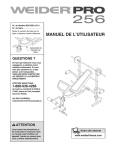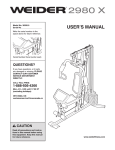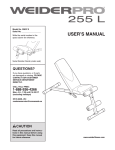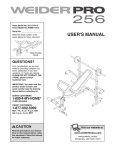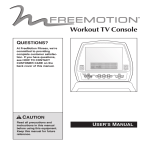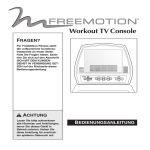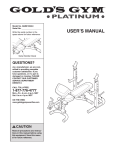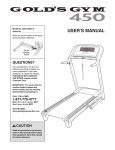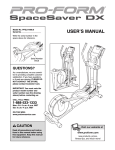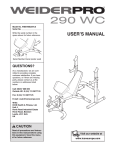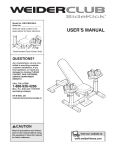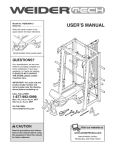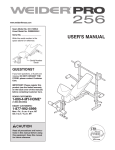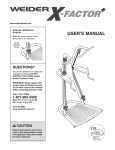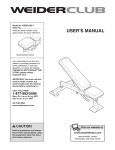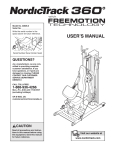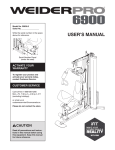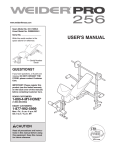Download Weider WECCBE1137 User's Manual
Transcript
Model No. WECCBE1137.0 Serial No. Write the serial number in the space above for future reference. USER'S MANUAL Serial Number Decal QUESTIONS? As a manufacturer, we are committed to providing complete customer satisfaction. If you have questions, or if parts are damaged or missing, PLEASE CONTACT OUR CUSTOMER SERVICE DEPARTMENT DIRECTLY. 1-888-936-4266 CALL TOLL-FREE: Mon.–Fri., 8:00 until 17:00 EST (excluding holidays) OR E-MAIL US: [email protected] CAUTION Read all precautions and instructions in this manual before using this equipment. Save this manual for future reference. w Visit our website at www.weiderfitness.com TABLE OF CONTENTS WARNING DECAL PLACEMENT . . . . . . . . . . . . . . . . . . . . . . . . . . . . . . . . . . . . . . . . . . . . . . . . . . . . . . . . . . . . . .2 IMPORTANT PRECAUTIONS . . . . . . . . . . . . . . . . . . . . . . . . . . . . . . . . . . . . . . . . . . . . . . . . . . . . . . . . . . . . . . . .3 BEFORE YOU BEGIN . . . . . . . . . . . . . . . . . . . . . . . . . . . . . . . . . . . . . . . . . . . . . . . . . . . . . . . . . . . . . . . . . . . . . .4 PART IDENTIFICATION CHART . . . . . . . . . . . . . . . . . . . . . . . . . . . . . . . . . . . . . . . . . . . . . . . . . . . . . . . . . . . . . .5 ASSEMBLY . . . . . . . . . . . . . . . . . . . . . . . . . . . . . . . . . . . . . . . . . . . . . . . . . . . . . . . . . . . . . . . . . . . . . . . . . . . . . . .6 ADJUSTMENT . . . . . . . . . . . . . . . . . . . . . . . . . . . . . . . . . . . . . . . . . . . . . . . . . . . . . . . . . . . . . . . . . . . . . . . . . . .10 EXERCISE GUIDELINES . . . . . . . . . . . . . . . . . . . . . . . . . . . . . . . . . . . . . . . . . . . . . . . . . . . . . . . . . . . . . . . . . . .12 PART LIST . . . . . . . . . . . . . . . . . . . . . . . . . . . . . . . . . . . . . . . . . . . . . . . . . . . . . . . . . . . . . . . . . . . . . . . . . . . . . .14 EXPLODED DRAWING . . . . . . . . . . . . . . . . . . . . . . . . . . . . . . . . . . . . . . . . . . . . . . . . . . . . . . . . . . . . . . . . . . . .15 ORDERING REPLACEMENT PARTS . . . . . . . . . . . . . . . . . . . . . . . . . . . . . . . . . . . . . . . . . . . . . . . . . .Back Cover LIMITED WARRANTY . . . . . . . . . . . . . . . . . . . . . . . . . . . . . . . . . . . . . . . . . . . . . . . . . . . . . . . . . . . . . .Back Cover WARNING DECAL PLACEMENT The decals shown here have been applied in the locations shown. If a decal is missing or illegible, call the telephone number on the front cover of this manual and request a free replacement decal. Apply the decal in the location shown. Note: The decals may not be shown at actual size. WEIDER is a registered trademark of ICON IP, Inc. 2 IMPORTANT PRECAUTIONS WARNING: To reduce the risk of serious injury, read all important precautions and instructions in this manual and all warnings on your weight bench before using your weight bench. ICON assumes no responsibility for personal injury or property damage sustained by or through the use of this product. 10. The weight bench is designed to support a maximum user weight of 300 lbs. (136 kg), and a maximum total weight of 410 lbs. (186 kg). Do not place more than 110 lbs. (50 kg), including a barbell and weights, on the weight rests. Do not place more than 30 lbs. (14 kg) on each fly arm. Do not place more than 50 lbs. (23 kg) on the leg lever. 1. Before beginning any exercise program, consult your physician. This is especially important for persons over the age of 35 or persons with pre-existing health problems. 2. Use the weight bench only as described in this manual. 3. It is the responsibility of the owner to ensure that all users of the weight bench are adequately informed of all precautions. 11. Do not use a barbell that is longer than five ft. (1.5 m) with the weight bench. 12. Always make sure there is an equal amount of weight on each side of your barbell when you are using it. When adding or removing weights, always keep some weight on both ends of the barbell to prevent the barbell from tipping. 4. The weight bench is intended for home use only. Do not use the weight bench in any commercial, rental, or institutional setting. 5. Keep the weight bench indoors, away from moisture and dust. Place the weight bench on a level surface, with a mat beneath it to protect the floor or carpet. Make sure that there is enough clearance around the weight bench to mount, dismount, and use the weight bench. 13. When you are using the leg lever, place a barbell with the same amount of weight on the weight rests to balance the bench. 14. When using the backrest in an inclined or level position, make sure that the support rod is inserted completely through the uprights and turned to the locked position. 6. Inspect and properly tighten all parts regularly. Replace any worn parts immediately. 7. Keep children under the age of 12 and pets away from the weight bench at all times. 15. If you feel pain or dizziness at any time while exercising, stop immediately and begin cooling down. 8. Keep hands and feet away from moving parts. 9. Always wear athletic shoes for foot protection while exercising. 3 BEFORE YOU BEGIN reading this manual, please see the front cover of this manual. To help us assist you, note the product model number and serial number before contacting us. The model number and the location of the serial number decal are shown on the front cover of this manual. Thank you for selecting the WEIDER® PRO 256 weight bench. The versatile weight bench is designed to develop every major muscle group of the body. Whether your goal is a shapely figure, dramatic muscle size and strength, or a healthier cardiovascular system, the weight bench will help you to achieve the specific results you want. Before reading further, please review the drawing below and familiarize yourself with the labeled parts. For your benefit, read this manual carefully before using the weight bench. If you have questions after ASSEMBLED DIMENSIONS: Height: 44 in. (112 cm) Width: 24 in. (61 cm) Depth: 59 in. (150 cm) Weight: 200 lbs. (91 kg) Weight Rest Barbell Backrest Support Rod Curl Pad Upright Fly Arm Weight Tube Leg Lever Weight Tube Seat 4 PART IDENTIFICATION CHART This chart is provided to help you identify the small parts used in assembly. The number in parenthesis below each part refers to the key number of the part from the PART LIST near the end of this manual. Important: Note: Some small parts may have been preattached. If a part is not in the parts bag, check to see if it has been preattached. M10 x 137mm Bolt (36) M10 x 120mm Bolt (19) M10 x 63mm Bolt (32) M6 Washer (26) M8 x 55mm Bolt (18) M8 x 43mm Bolt (39) M8 x 42mm Carriage Bolt (37) M10 Nylon Locknut (33) M8 Washer (16) M8 Nylon Locknut (17) M10 Washer (34) M6 x 38mm Screw (30) M6 x 16mm Screw (29) 5 ASSEMBLY • For help identifying small parts, use the PART IDENTIFICATION CHART on page 5. Make Things Easier for Yourself Everything in this manual is designed to ensure that the weight bench can be assembled successfully by almost anyone. By setting aside plenty of time, assembly will go smoothly. • As you assemble the weight bench, make sure all parts are oriented as shown in the drawings. • Tighten all parts as you assemble them, unless instructed to do otherwise. Before beginning assembly, carefully read the following information and instructions: • The included grease and the following tools (not included) may be required for assembly: • Assembly requires two people. Two adjustable wrenches • Because of its size, the weight bench should be assembled in the location where it will be used. Make sure that there is enough clearance to walk around the weight bench as you assemble it. One rubber mallet One standard screwdriver One Phillips screwdriver • Place all parts in a cleared area and remove the packing materials. Do not dispose of the packing materials until assembly is completed. 1. Assembly will be more convenient if you have a socket set, a set of open-end or closed-end wrenches, or a set of ratchet wrenches. 1 Before assembling the weight bench, make sure that you have read and understand the information in the box above. Orient the Crossbar (3) so that the warning decals are on top. Attach the Crossbar to an Upright (1) with two M8 x 55mm Bolts (18), two M8 Washers (16), and two M8 Nylon Locknuts (17); do not tighten the Nylon Locknuts yet. 1 3 Attach the Crossbar (3) to the other Upright (1) in the same way. 1 18 16 Warning Decals 18 2. Orient the Stabilizer (13) so that the indented holes are facing the floor. Attach the Front Leg (8) to the Stabilizer with two M8 x 42mm Carriage Bolts (37) and two M8 Nylon Locknuts (17); do not tighten the Nylon Locknuts yet. 2 17 Indents 37 6 8 17 13 17 3. Attach the Front Leg (8) to the Frame (2) with two M8 x 43mm Bolts (39), four M8 Washers (16), and two M8 Nylon Locknuts (17); do not tighten the Nylon Locknuts yet. 3 16 39 16 8 4. Attach the Frame (2) to the Crossbar (3) with three M8 x 55mm Bolts (18), two M8 Washers (16), and three M8 Nylon Locknuts (17); do not tighten the Nylon Locknuts yet. 2 16 17 4 18 16 2 5. Apply some of the included grease to an M10 x 63mm Bolt (32). Attach the Leg Lever (4) to the Front Leg (8) with the Bolt and an M10 Nylon Locknut (33). Do not overtighten the Nylon Locknut; the Leg Lever must pivot easily. 5 32 4 3 17 18 17 Grease 33 8 6. Insert a Long Pad Tube (10) into a hole in the Leg Lever (4). Slide two Foam Pads (23) onto the Long Pad Tube. 6 23 Attach the other Long Pad Tube (10) and Foam Pads (23) in the same way. 23 7 10 23 4 10 23 7. Attach the Backrest Tubes (5) to the Backrest (6) with four M6 x 38mm Screws (30) and four M6 Washers (26); do not tighten the Screws yet. 7 6 26 5 26 30 30 8. Insert the Support Rod (7) into a set of holes in the Uprights (1). Rotate the Support Rod to the locked position, with the locking pin wrapped around the left Upright. 8 Grease 1 1 34 Grease an M10 x 137mm Bolt (36). Attach the Backrest Tubes (5) to the welded tube on the Frame (2) with the Bolt, two M10 Washers (34), and an M10 Nylon Locknut (33). Do not overtighten the Nylon Locknut; the Backrest Tubes must pivot easily. 36 2 See steps 1–4. Tighten the M8 Nylon Locknuts (17). See step 7. Tighten the M6 x 38mm Screws (30). 7 5 34 Welded Tube 9. Attach the Seat (11) to the Frame (2) with four M6 x 16mm Screws (29). 9 11 Locking Pin 33 2 29 10. Slide a Weight Stop (28) onto the weight tube on a Fly Arm (25). 10 Slide a Weight Stop (not shown) onto the other Fly Arm (not shown) in the same way. 25 Weight Tube 8 28 11. Attach a Fly Arm (25) to an Upright (1) with an M10 x 120mm Bolt (19) and an M10 Nylon Locknut (33). Make sure that the Fly Arm is on the outside of the Fly Arm Stop (15). Do not overtighten the Nylon Locknut; the Fly Arm must pivot easily. 11 25 1 Attach the other Fly Arm (25) in the same way. 25 19 12. Insert an Arm Pad Tube (12) into the indicated hole in a Fly Arm (25) from the side shown. Next, slide a Foam Pad (23) onto the Arm Pad Tube; the Foam Pad will hold the Arm Pad Tube in place. 12 Repeat this step with the other Fly Arm (not shown). 15 12 25 23 13. Insert the Inner Bar (43) into the Outer Bar (40) and align the indicated holes. Using a hammer, tap the two Roll Pins (41) into the holes until they are flush with the Outer Bar. 13 40 14. Attach the Curl Pad (45) to the Curl Post (27) with two M6 x 16mm Screws (29). 41 Holes 41 43 Holes 14 29 45 15. Make sure that all parts are properly tightened before the weight bench is used. Note: Some hardware may be left over after assembly is completed. The use of all remaining parts will be explained in ADJUSTMENT, starting on page 10. 27 9 33 ADJUSTMENT The steps below explain how the weight bench can be adjusted. See the accompanying exercise guide to see the correct form for several exercises. Make sure all parts are properly tightened each time the weight bench is used. Replace any worn parts immediately. The weight bench can be cleaned with a damp cloth and a mild, non-abrasive detergent; do not use solvents. ADJUSTING THE BACKREST 1 The Backrest (6) can be used in a declined position, a level position, or any of three inclined positions. To use the Backrest in a declined position, remove the Support Rod (7) and lay the Backrest on the Crossbar (3). To use the Backrest (6) in a level position or an inclined position, insert the Support Rod (7) into a set of holes in the Uprights (1). Rotate the Support Rod to the locked position, with the locking pin wrapped around the left Upright. Rest the Backrest on the Support Rod. 6 1 7 3 Locking Pin ATTACHING WEIGHTS TO THE LEG LEVER OR THE FLY ARMS To use the Leg Lever (4), slide the desired weights onto the weight tube on the Leg Lever. Do not place more than 50 lbs. (23 kg) on the Leg Lever. To use the Fly Arms (25), make sure there is a Weight Stop (28) on each weight tube. Next, slide the desired amount of weight onto the weight tubes. Do not place more than 30 lbs. (14 kg) on each Fly Arm. 4 When using the Leg Lever (4), place a barbell with the same amount of weight on the weight rests to balance the bench. Weight Tube Weight WARNING: 25 28 Weight 10 Weight Tube ATTACHING WEIGHTS TO THE BARBELL Slide an equal amount of Weight (38, 44) onto each end of the barbell. Slide the two Lock Collars (42) against the Weights, and tighten them fully. 38 WARNING: Always secure the Weights (38, 44) on the barbell with the Lock Collars (42). Never use the barbell with more than 100 lbs. (45 kg). 42 ATTACHING THE CURL PAD 44 38 44 Barbell 45 For some exercises, the Curl Pad (45) must be attached to the weight bench. Remove the 30mm Square Inner Cap (22) from the Front Leg (8). Insert the Curl Post (27) into the Front Leg, and align an adjustment hole in the Curl Post with the adjustment hole in the Front Leg. Secure the Curl Post with the Curl Knob (31). 27 22 Hole Note: When the Curl Pad (45) is not being used, store it away from the weight bench, and insert the 30mm Square Inner Cap (22) into the Front Leg (8). 8 11 Adjustment Hole 31 42 EXERCISE GUIDELINES THE FOUR BASIC TYPES OF WORKOUTS PERSONALIZING YOUR EXERCISE PROGRAM Muscle Building To increase the size and strength of your muscles, push them close to their maximum capacity. Your muscles will continually adapt and grow as you progressively increase the intensity of your exercise. You can adjust the intensity level of an individual exercise in two ways: • by changing the amount of resistance used • by changing the number of repetitions or sets performed. (A “repetition” is one complete cycle of an exercise, such as one sit-up. A “set” is a series of repetitions.) Determining the appropriate length of time for each workout, and the numbers of repetitions and sets to complete, is an individual matter. Avoid overdoing it during the first few months of your exercise program. Progress at your own pace and be sensitive to your bodyʼs signals. If you experience pain or dizziness while exercising, stop immediately and cool down; find out what is wrong before continuing. Remember that adequate rest and a proper diet are important factors in any exercise program. WARMING UP The proper amount of resistance for each exercise depends upon the individual user. You must gauge your limits and select the amount of resistance that is right for you. Begin with 3 sets of 8 repetitions for each exercise you perform. Rest for 3 minutes after each set. When you can complete 3 sets of 12 repetitions without difficulty, increase the amount of resistance. Begin each workout with 5 to 10 minutes of stretching and light exercise to warm up. Warming up prepares your body for more strenuous exercise by increasing circulation, raising your body temperature and delivering more oxygen to your muscles. WORKING OUT Toning You can tone your muscles by pushing them to a moderate percentage of their capacity. Select a moderate amount of resistance and increase the number of repetitions in each set. Complete as many sets of 15 to 20 repetitions as possible without discomfort. Rest for 1 minute after each set. Work your muscles by completing more sets rather than by using high amounts of resistance. Each workout should include 6 to 10 different exercises. Select exercises for every major muscle group, emphasizing areas that you want to develop most. To give balance and variety to your workouts, vary the exercises from session to session. Schedule your workouts for the time of day when your energy level is the highest. Each workout should be followed by at least one day of rest. Once you find the schedule that is right for you, stick with it. Weight Loss To lose weight, use a low amount of resistance and increase the number of repetitions in each set. Exercise for 20 to 30 minutes, resting for a maximum of 30 seconds between sets. EXERCISE FORM Cross Training Cross training is an efficient way to get a complete and well-balanced fitness program. An example of a balanced program follows: • Plan strength training workouts on Monday, Wednesday, and Friday. • Plan 20 to 30 minutes of aerobic exercise, such as running on a treadmill or riding on an elliptical exerciser or exercise cycle, on Tuesday and Thursday. • Rest from both strength training and aerobic exercise for at least one full day each week to give your body time to regenerate. The combination of strength training and aerobic exercise will reshape and strengthen your body, plus develop your heart and lungs. Maintaining proper form is an essential part of an effective exercise program. This requires moving through the full range of motion for each exercise, and moving only the appropriate parts of the body. Exercising in an uncontrolled manner will leave you feeling exhausted. On the exercise guide accompanying this manual you will find photographs showing the correct form for several exercises, and a list of the muscles affected. Refer to the muscle chart on the next page to find the names of the muscles. The repetitions in each set should be performed smoothly and without pausing. The exertion stage of each repetition should last about half as long as the return stage. Proper breathing is important. Exhale during the exertion stage of each repetition and inhale during the return stage. Never hold your breath. 12 Rest for a short period of time after each set. The ideal resting periods follow: • Rest for three minutes after each set for a muscle building workout. • Rest for one minute after each set for a toning workout. • Rest for 30 seconds after each set for a weight loss workout. Plan to spend the first couple of weeks familiarizing yourself with the equipment and learning the proper form for each exercise. slowly as you stretch and do not bounce. Ease into each stretch gradually and go only as far as you can without strain. Stretching at the end of each workout is an effective way to increase flexibility. STAYING MOTIVATED For motivation, keep a record of each workout. List the date, the exercises performed, the resistance used, and the numbers of sets and repetitions completed. Record your weight and key body measurements at the end of every month. Remember, the key to achieving the greatest results is to make exercise a regular and enjoyable part of your everyday life. COOLING DOWN End each workout with 5 to 10 minutes of stretching. Include stretches for both your arms and legs. Move O A P L B C Q R D S E H G F M N U T V I W J X K 13 MUSCLE CHART A. B. C. D. E. F. G. H. I. J. K. L. M. N. O. P. Q. R. S. T. U. V. W. X. Sternomastoid (neck) Pectoralis Major (chest) Biceps (front of arm) Obliques (waist) Brachioradials (forearm) Hip Flexors (upper thigh) Abductor (outer thigh) Quadriceps (front of thigh) Sartorius (front of thigh) Tibialis Anterior (front of calf) Soleus (front of calf) Anterior Deltoid (shoulder) Rectus Abdominus (stomach) Adductor (inner thigh) Trapezius (upper back) Rhomboideus (upper back) Posterior Deltoid (shoulder) Triceps (back of arm) Latissimus Dorsi (mid back) Spinae Erectors (lower back) Gluteus Medius (hip) Gluteus Maximus (buttocks) Hamstring (back of leg) Gastrocnemius (back of calf) PART LIST—Model No. WECCBE1137.0 Key No. 1 2 3 4 5 6 7 8 9 10 11 12 13 14 15 16 17 18 19 20 21 22 23 24 Qty. 2 1 1 1 2 1 1 1 8 2 1 2 1 4 2 10 11 7 2 1 4 9 6 5 Description Upright Frame Crossbar Leg Lever Backrest Tube Backrest Support Rod Front Leg 19mm Round Inner Cap Long Pad Tube Seat Arm Pad Tube Stabilizer Plastic Bushing Fly Arm Stop M8 Washer M8 Nylon Locknut M8 x 55mm Bolt M10 x 120mm Bolt 25mm Round Angled Cap 38mm Square Inner Cap 30mm Square Inner Cap Foam Pad 25mm Round Inner Cap Key No. 25 26 27 28 29 30 31 32 33 34 35 36 37 38 39 40 41 42 43 44 45 * * * Qty. 2 4 1 2 6 4 1 1 4 2 4 1 2 4 2 1 2 2 1 2 1 – – – Description Fly Arm M6 Washer Curl Post Weight Stop M6 x 16mm Screw M6 x 38mm Screw Curl Knob M10 x 63mm Bolt M10 Nylon Locknut M10 Washer 25mm Square Inner Cap M10 x 137mm Bolt M8 x 42mm Carriage Bolt 15-pound Weight M8 x 43mm Bolt Outer Bar Roll Pin Lock Collar Inner Bar 10-lb. Weight Curl Pad Userʼs Manual Exercise Guide Grease Packet R0508A Note: Specifications are subject to change without notice. See the back cover of this manual for information about ordering replacement parts. *These parts are not illustrated. 14 EXPLODED DRAWING—Model No. WECCBE1137.0 9 6 7 23 22 28 12 9 14 19 45 16 16 31 39 16 32 34 35 10 22 2 17 13 9 23 18 19 30 18 18 16 3 33 18 25 18 17 17 18 14 9 22 28 15 12 14 33 16 16 17 21 21 43 24 24 42 38 44 15 1 41 40 23 30 24 22 9 34 22 42 26 26 23 37 10 9 29 29 17 33 17 20 22 11 16 4 9 36 22 8 22 24 33 15 21 22 23 14 35 5 21 29 27 17 25 24 1 9 R0508A 38 R1107A ORDERING REPLACEMENT PARTS To order replacement parts, please see the front cover of this manual. To help us assist you, be prepared to provide the following information when contacting us: • the model number and serial number of the product (see the front cover of this manual) • the name of the product (see the front cover of this manual) • the key number and description of the replacement parts(s) (see the PART LIST and the EXPLODED DRAWING near the end of this manual) LIMITED WARRANTY ICON Health & Fitness, Inc. (ICON) warrants this product to be free from defects in workmanship and material, under normal use and service conditions, for a period of ninety (90) days from the date of purchase. This warranty extends only to the original purchaser. ICON's obligation under this warranty is limited to replacing or repairing, at ICON's option, the product through one of its authorized service centers. All repairs for which warranty claims are made must be pre-authorized by ICON. If the product is shipped to a service center, freight charges to and from the service center will be the customerʼs responsibility. For in-home service, the customer will be responsible for a minimal trip charge. This warranty does not extend to any product or damage to a product caused by or attributable to freight damage, abuse, misuse, improper or abnormal usage or repairs not provided by an ICON authorized service center; products used for commercial or rental purposes; or products used as store display models. No other warranty beyond that specifically set forth above is authorized by ICON. ICON is not responsible or liable for indirect, special or consequential damages arising out of or in connection with the use or performance of the product or damages with respect to any economic loss, loss of property, loss of revenues or profits, loss of enjoyment or use, costs of removal or installation or other consequential damages of whatsoever nature. Some provinces do not allow the exclusion or limitation of incidental or consequential damages. Accordingly, the above limitation may not apply to you. The warranty extended hereunder is in lieu of any and all other warranties and any implied warranties of merchantability or fitness for a particular purpose is limited in its scope and duration to the terms set forth herein. Some provinces do not allow limitations on how long an implied warranty lasts. Accordingly, the above limitation may not apply to you. This warranty gives you specific legal rights. You may also have other rights which vary from state to state. ICON OF CANADA, INC., 900 de lʼIndustrie, St. Jérôme, QC J7Y 4B8 Part 267063 R0508A Printed in Cananda © 2008 ICON IP, Inc.
















